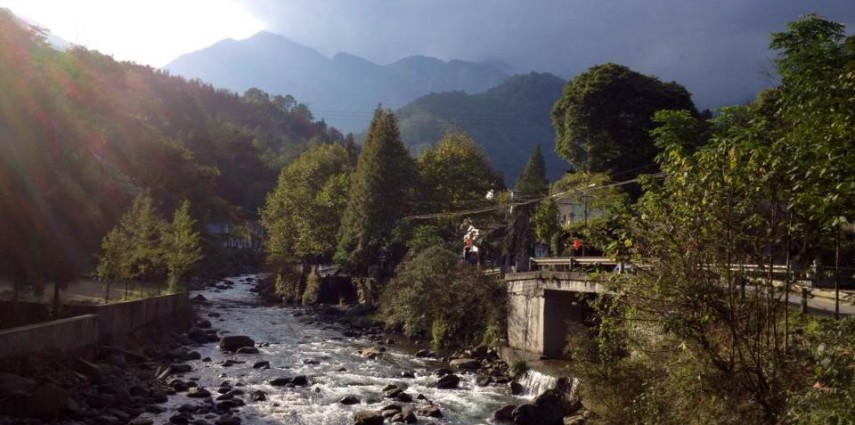Good food is about more than what’s on the table; It’s about where the food came from and how it got there. Quality ingredients make better tasting food and people in many rural areas in Sichuan’s fertile basin realize this and are proud of how they get their ingredients and cook their food. So we headed out to the hills of Chongzhou, near Qingcheng Mountain (the birthplace of Taosim) to learn from a local family about foraging, home-made ingredients and freshness.

The Zhang’s woodfired kitchen stove
We drove up the continuously narrowing road to Mr. Zhang’s small Mountain Inn where I had first met him a few years before. A smattering of houses dot the roadside, some of the larger ones converted to inns, still smaller wooden ones set back from the road with only dirt paths. Despite the mountainous terrain the people in Jiulong Valley still farm and raise as much as they can on site. The Zhang’s have a modest garden in the hills, raise their own chickens and pigs, press their own oil from locally grown canola seeds, and forage for fresh seasonal ingredients to supplement their harvest.

A field of canola near Jiulong Valley
This is the way of life here as it has been for generations, but Mr. Zhang is keenly aware that fresh, local greens and free-range livestock, grown in the clear countryside air are considerably better tasting than their counterparts, and he brims with pride as he describes their freshness.

Our mother-daughter team of guides
Mr. Zhang’s wife and mother spend time each season crawling the mountain that is their backyard for greens, bamboo shoots, mushrooms and fungus as they become available. In March, when we went, we were looking in particular for one thing: Zhe’er Gen( 折耳根), the edible rhizome of Houttuynia cordata. Zhe’er Gen is a pungent fishy, peppery plant of which the leaves and roots are eaten, and it is very particular in its taste and polarizing in its reception. It is eaten mostly in Southwest China (Guizhou, Yunnan & Sichuan), and is as loved by locals as it is hated by others. Being early in the season as it was we sliced the leaves off with a knife about half an inch under the soil, to allow it to grow back instead of pulling the roots out altogether.
- A handful of Zhe’er Gen
- Mrs. Zhang collecting
While it was the season for ‘Fish Grass’ as it is sometimes known we also came across and picked wild chives, Qinghao (a member of the artemisia family) and Duck’s Foot. Mr. Zhang’s wife and daughter led us deep into the hills to the soggy soil where the Zhe’er Gen grows best, filling a large bamboo backpack with as much as we needed for dinner.

Bamboo back-pack with some of our pickings
Each ingredient fits specifically into its place in the Sichuan recipe book, and Mrs. Zhang explained how some were meant to be mixed raw with chili oil as a spicy salad, cooked with garlic or fried with an egg. Mr Zhang’s mother told us how each also fit into its role in Chinese medicine, clearing toxins from the lungs, or helping digestion.

A packet or Qing Hao
We returned to the Inn where Mr Zhang had just prepared a free range ‘mountain-chicken’ he had raised, and strung it up on a home-made stand over an open fire. He proudly explained how much better the chicken would taste than any we could find in the city as he prepared our collection of foraged goodies.

Mr. & Mrs. Zhang posing with the chicken (dinner)
There is something incredibly satisfying about a meal which you sourced yourself and that relies on the freshness of the ingredients themselves for flavor. Sitting around the fire, enjoying the spoils of our labor we are brought back to a time where we are more connected to our food and its sources, and all inevitably see (and taste) what makes Mr. Zhang so proud.

This is how you roast a chicken!
Get in touch to learn more about foraging trips in Jiulong Valley and other places further afield. April is bamboo shoot season!



